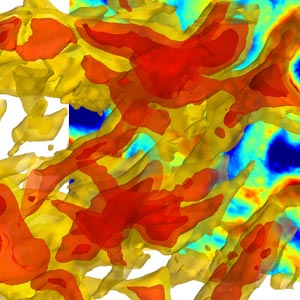KTH enters the petaflop era with new supercomputer

Fusion research simulated with supercomputers. (Photo: KTH PDC)
Sweden's KTH Royal Institute of Technology is due to begin using the fastest academic supercomputer of any university in Scandinavia. A Cray XC30 with 1,676 nodes and a memory of 104.7 terabytes will be installed at KTH’s PDC Center for High Performance Computing.
Access to the updated computational capacity will be through the Swedish National Infrastructure for Computing, SNIC.
Some of the uses for the computer will include fluid dynamics, climate modelling, plasma physics, neuroscience, materials science and molecular simulation.
The new system will operate at a peak performance of nearly 2 petaflops, which will make it six times faster than the university’s current supercomputer, Lindgren.
A single petaflop is equal to one thousand million (1015) floating-point operations per second. And like Lindgren, the new computer will be named after yet another renowned Swedish children’s author – in this case, Elsa Beskow.
The investment in KTH’s new supercomputer – including supporting systems, storage and running costs – has a budget of 170 million SEK divided over four years.
The funding comes primarily from SNIC, KTH and industry. After the installation of the system in October, there will be a period of preliminary testing, with the system expected to be in full production on January 1, 2015.
The supercomputer will be physically located at KTH’s supercomputer centre PDC.
Media Contact
All latest news from the category: Physics and Astronomy
This area deals with the fundamental laws and building blocks of nature and how they interact, the properties and the behavior of matter, and research into space and time and their structures.
innovations-report provides in-depth reports and articles on subjects such as astrophysics, laser technologies, nuclear, quantum, particle and solid-state physics, nanotechnologies, planetary research and findings (Mars, Venus) and developments related to the Hubble Telescope.
Newest articles

Webb captures top of iconic horsehead nebula in unprecedented detail
NASA’s James Webb Space Telescope has captured the sharpest infrared images to date of a zoomed-in portion of one of the most distinctive objects in our skies, the Horsehead Nebula….

Cost-effective, high-capacity, and cyclable lithium-ion battery cathodes
Charge-recharge cycling of lithium-superrich iron oxide, a cost-effective and high-capacity cathode for new-generation lithium-ion batteries, can be greatly improved by doping with readily available mineral elements. The energy capacity and…

Novel genetic plant regeneration approach
…without the application of phytohormones. Researchers develop a novel plant regeneration approach by modulating the expression of genes that control plant cell differentiation. For ages now, plants have been the…





















